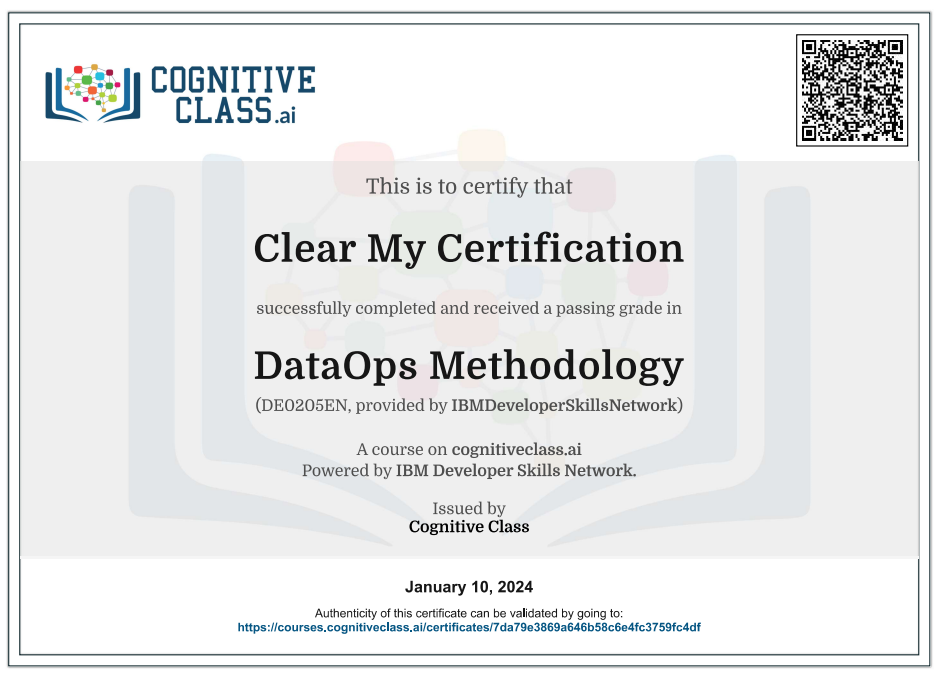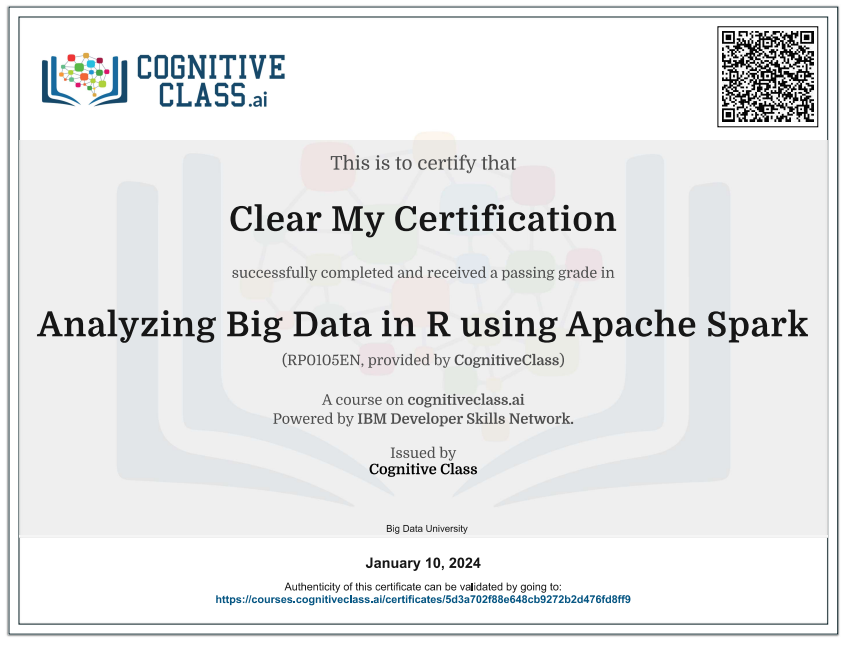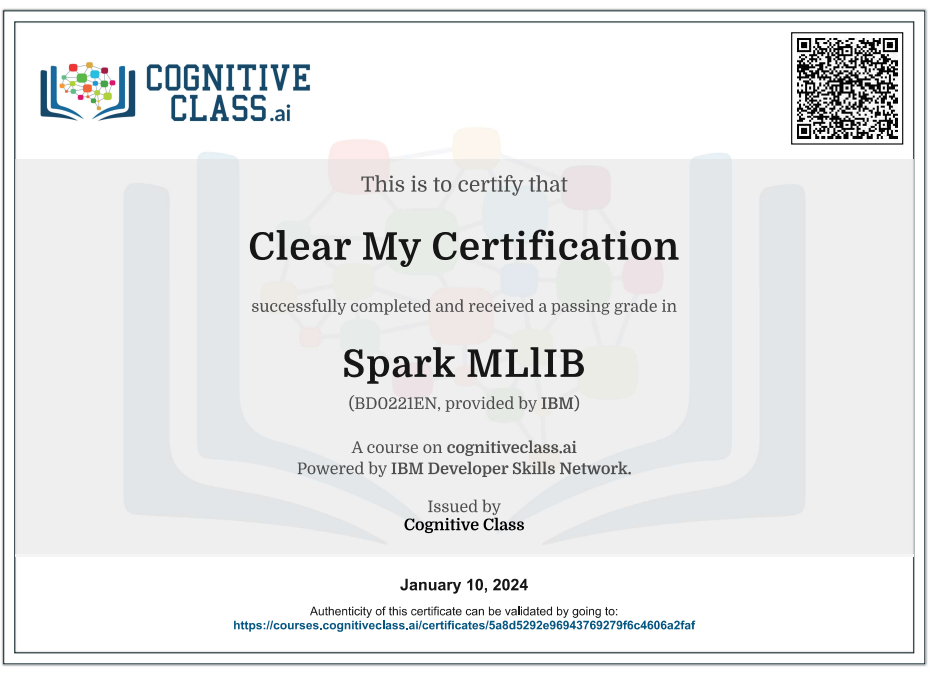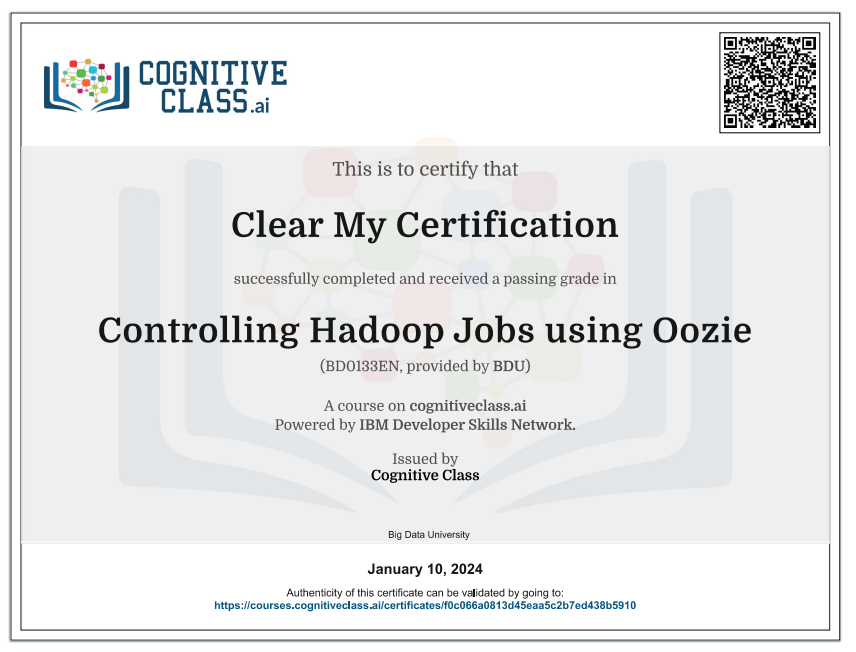Enroll Here: DataOps Methodology Cognitive Class Exam Quiz Answers
DataOps Methodology Cognitive Class Certification Answers

Module 1 – Establish DataOps Quiz Answers – Cognitive Class
Lesson 2 – Establish Data Strategy Quiz Answers – Cognitive Class
Question 1: Before we can put together a data strategy, we need to have a good understanding of the data available and how it is used in the organization.
- True
- False
Question 2: What is a data strategy?
- An architecture and actionable roadmap along with an action plan
- A competitive publication to show that our organization is modern
- A plan to move all legacy data systems to the cloud
Question 3: Implementing a data strategy should always result in cost savings in the year the plan is realized.
- True
- False
Question 4: Which of the following statements about Data Strategy are correct?
- Whatever the type of data, it should only include internally produced data
- All types of data – both structured and unstructured need to be considered
- Volumes of data have increased hugely, but are now starting to stabilize
- Only business executives should be consulted in putting together a strategy
Question 5: Data Governance is a key part of executing a data strategy.
- True
- False
Lesson 3 – Establish Team Quiz Answers – Cognitive Class
Question 1: A DataOps team consists of members mostly from IT departments.
- True
- False
Question 2: Which of the following roles are active team members of any DataOps team?
- Chief Technology Officer
- Chief Data Officer
- Data Engineer
- Database Administrator
- Data Steward
- Data Architect
- Data Scientist
Question 3: Creating and maintain business terms is a major responsibility of which following role?
- Data Engineer
- Data Quality Analyst
- Data Steward
- Data Scientist
Question 4: Only Chief Data Officer can update the KPIs for a data sprint.
- True
- False
Question 5: DataOps relies heavily on the use of automation, so that communication among team members is not necessary.
- True
- False
Module 2 – Establish DataOps-Optimize for Operation Quiz Answers – Cognitive Class
Lesson 1 – Establish Toolchain Quiz Answers – Cognitive Class
Question 1: DataOpstoolchain helps you deliver quality data slowly.
- True
- False
Question 2: DataOpsToolchain and DevOps are the same thing.
- True
- False
Question 3: DataOpsToolchain can work without DataOps API(s).
- True
- False
Question 4: What are the key components of DataOpsToolchain?
- Continuous Deployment
- Communication
- Source Control
- All of above
Question 5: Who is responsible for creating DataOpsToolchain? (Choose all that apply)
- Data Scientist
- Administrator
- DBA
- Data Engineer
Lesson 2 – Establish Baseline Quiz Answers – Cognitive Class
Question 1: Data Management is the same as Information Governance.
- True
- False
Question 2: What is the most costly result from an external influence to an organization?
- Data Breach Fines and Penalties
- Insurance Policy Payout
- Claim Settlement
- None of these
Question 3: Reference data is defined as data used as a permissible value within a data field.
- True
- False
Lesson 3 – Establish Business Priorities Quiz Answers – Cognitive Class
Question 1: Business Priority should be the primary focus when deciding what the DataOps team should do.
- True
- False
Question 2: What is a data backlog?
- A bottleneck in the data pipeline
- A list of all data sources
- A prioritized set of requirements expressed as data tasks
- A plan to move all data into a catalog
Question 3: A prioritized data backlog will reduce the time taken to start the next DataOps iteration.
- True
- False
Question 4: A Data Task should be prioritized by considering:
- The cost of providing the data
- The career advancement possibilities of solving business challenges
- The impact to sales from implementing the data pipeline
- All of the above
Question 5: KPIs are used to determine the progress and throughput of a DataOps data sprint.
- True
- False
Module 3 – Iterate Dataops – Know Your Data Quiz Answers – Cognitive Class
Lesson 1 – Discover Quiz Answers – Cognitive Class
Question 1: You will need someone on your team with detailed knowledge of the business processes you’re going to analyze so selected data elements are appropriate to reaching your objectives.
- True
- False
Question 2: What should you do if you identify gaps or mismatches in the data required for the analysis?
- Rethink how you will do the analysis with different data
- Create the missing data
- Find a new source for the missing or mismatched data
- All of the above
Question 3: You should trace the linage of data elements to be used for analysis to make sure they come from a trusted source.
- True
- False
Question 4: What is the primary objective of the Discover phase?
- Decide what the analytics team wants to have for lunch
- Identify and locate the specific data elements required to accomplish an analysis
- Uncover the meaning of data column headers and how they relate to the underlying data
- Gain an understanding of the business goals and KPIs of an analysis effort
Question 5: A Data Engineer who thoroughly understands where specific data resides, including the specific databases and files where each identified data element resides, should be involved in Data Discovery process.
- True
- False
Lesson 2 – Classify Quiz Answers – Cognitive Class
Question 1: Classification of each data element will make it easier going forward for users to distinguish the meaning and applicability of the data for their purposes.
- True
- False
Question 2: Which description best defines taxonomy?
- Organizing data elements into meaningful structures
- An IBM network protocol which reduces network latency
- The art of preparing, stuffing, and mounting the skins of animals with lifelike effect
Question 3: A single data element can be placed into an unlimited number of data domains.
- True
- False
Question 4: Which of the following is the objective of classification?
- To bring out points of similarity and dissimilarity among various groups
- To present data in a simple, logical and understandable form
- To condense the mass of data
- All of the above
Question 5: You should design workflows which are specific to the classification tool you are using.
- True
- False
Module 4 – Iterate Dataops Quiz Answers – Cognitive Class
Lesson 1 – Manage Qualities & Entities Quiz Answers – Cognitive Class
Question 1: Data quality is data accuracy.
- True
- False
Question 2: All data across the enterprise should have the same data quality.
- True
- False
Question 3: A data quality framework consists of which of the following 4 phases:
- Profile
- Define
- Remediate
- Monitor
- Assess
- Deploy
Question 4: When assessing data quality, you only need the data set containing the data, metadata is optional.
- True
- False
Lesson 2 – Manage Policies Quiz Answers – Cognitive Class
Question 1: How does data classification affect defining policies?
- Inheritance, retention and probabilities
- Protection, reporting and inheritance
- Protection, accessibility and retention
- Retention, deletion and storage
Question 2: What impact does a highly sensitive classification have on a policy definition?
- Require data anonymization, de-identification, and masking
- Limit access to the data and/or require data masking
- Limit access to the data and make it unprintable
- No impact
Question 3: What are the most common state, country or regional regulations affecting personal information?
- SIN, SSN and BAN
- FDIC, BCBS and SOX
- CCPA, GDPR and LGPD
- PCI, PII and PHI
Question 4: Once policies have been defined affecting the data, rules must be enforced to act.
- True
- False
Module 5 – Iterate Dataops – Use Your Data Quiz Answers – Cognitive Class
Lesson 1 – Self Service Quiz Answers – Cognitive Class
Question 1: Self Service of data is only possible when any data movement and transformation required to join multiple data assets have been performed.
- True
- False
Question 2: Self Service can use the following governance artefacts to refine a search in a catalog. (Choose all that apply)
- Data Protection Rules
- Business Terms
- Tags
Question 3: A data consumer should not be able to access data that has been identified as sensitive, where there is not a business need to do so.
- True
- False
Question 4: Which of the following statements about Self Service are correct?
- Data consumers typically do not know how to manipulate the data
- Data Protection rules prevent a data consumer from inadvertently seeing data that is sensitive
- Creating multiple catalogs can partition data assets by their content and anticipated audience
- A data consumer needs to know SQL to join multiple data assets
Question 5: Data Consumers provide valuable input to data scientists by clarifying the combination of data assets and how they need to be transformed, prior to data movement being designed and implemented.
- True
- False
Lesson 2 – Manage Movement & Integration Quiz Answers – Cognitive Class
Question 1: You should define the use case at the outset of a Data Movement and Integration project to support a “Build It and They Will Come” strategy.
- True
- False
Question 2: Which of the following does not represent a data integration pattern:
- Data virtualization
- Data replication
- Data lineage
- Message-oriented movement
- Bulk/batch
Question 3: Which of the following is not a Data Movement and Integration Job Design consideration?
- Design for reusability
- Deployment models (e.g. Containers, Kubernetes Orchestration, OpenShift)
- Design for parallel processing
- Everything should be programmed in Python
- Design for job portability (build once and run anywhere)
Question 4: Hand coding generally provides a 10X productivity gain over commercial data integration software tooling.
- True
- False
Question 5: Which of the following is not an example of a message queuing system?
- Kafka
- VSAM
- Microsoft Azure Queues
- GCP PubSub
- AWS Simple Queue Service
- MQ
Lesson 3 – Improve/Complete Quiz Answers – Cognitive Class
Question 1: DataOps is a completely new methodology and it doesn’t learn anything from agile and devOps.
- True
- False
Question 2: Data consumers can first start to provide feedback to the current data sprint in the stakeholder review meeting.
- True
- False
Question 3: Which of the following assets or artifacts could be found in catalog?
- Code
- Business terms
- Data rules
- Source data
- Data lineage
Question 4: All issues need to be remediated before moving on to the next data sprint.
- True
- False
Question 5: Completing a data sprint involves publishing governed artifacts and data assets to a production environment.
- True
- False
Module 6 – Improve Dataops Quiz Answers – Cognitive Class
Question 1: DataOps is a fixed process which should not be changed once defined.
- True
- False
Question 2: Improvements to the DataOps process could involve changes to
- Technology used in DataOps
- DataOps team roles and responsibilities
- Processes for ETL
- All of the above
Question 3: Reviewing the Data classification phase involves reviewing how accurate the data mappings to the business terms are.
- True
- False
Question 4: Reviewing the Establish Baseline Process should include reviewing how effective the processes are for establishing a baseline for –
- External Regulatory requirements
- Organization maturity and Readiness
- Governance and Oversight
- All of the above
Question 5: KPIs are key in determining the effectiveness of all parts of the DataOps process.
- True
- False
DataOps Methodology Final Exam Answers – Cognitive Class
Question 1: What is a data strategy?
- An architecture and actionable roadmap along with an action plan
- A competitive publication to show that our organization is modern
- A plan to move all legacy data systems to the cloud
Question 2: Which of the following statements about Data Strategy are correct?
- Whatever the type of data, it should only include internally produced data
- All types of data – both structured and unstructured need to be considered
- Volumes of data have increased hugely, but are now starting to stabilize
- Only business executives should be consulted in putting together a strategy
Question 3: Which of the following roles are active team members of any DataOps team?
- Chief Technology Officer
- Chief Data Officer
- Data Engineer
- Database Administrator
- Data Steward
- Data Architect
- Data Scientist
Question 4: Creating and maintaining business terms is a major responsibility of which following role?
- Data Engineer
- Data Quality Analyst
- Data Steward
- Data Scientist
Question 5: Business Priority should be the primary focus when deciding what the DataOps team should do.
- True
- False
Question 6: What is a data backlog?
- A bottleneck in the data pipeline
- A list of all data sources
- A prioritized set of requirements expressed as data tasks
- A plan to move all data into a catalog
Question 7: A Data Task should be prioritized by considering:
- The cost of providing the data
- The career advancement possibilities of solving business challenges
- The impact to sales from implementing the data pipeline
- All of the above
Question 8: KPIs are used to determine the progress and throughput of a DataOps data sprint.
- True
- False
Question 9: What are key components of DataOps toolchain?
- Continuous Deployment
- Communication
- Source Control
- All of above
Question 10: Who is responsible for creating DataOps toolchain? (Choose all that apply)
- Data Scientist
- Administrator
- DBA
- Data Engineer
Question 11: What is the primary objective of the Discover phase?
- Decide what the analytics team wants to have for lunch.
- Identify and locate the specific data elements required to accomplish an analysis
- Uncover the meaning of data column headers and how they relate to the underlying data.
- Gain an understanding of the business goals and KPIs of an analysis effort.
Question 12: Which description best defines taxonomy?
- Organizing data elements into meaningful structures.
- An IBM network protocol which reduces network latency.
- The art of preparing, stuffing, and mounting the skins of animals with lifelike effect.
Question 13: Which of the following is the objective of classification?
- To bring out points of similarity and dissimilarity among various groups.
- To present data in a simple, logical and understandable form.
- To condense the mass of data.
- All of the above
Question 14: A data quality framework consists of which of the following 4 phases:
- Profile
- Define
- Remediate
- Monitor
- Assess
- Deploy
Question 15: How does data classification affect defining policies?
- Inheritance, retention and probabilities
- Protection, reporting and inheritance
- Protection, accessibility and retention
- Retention, deletion and storage
Question 16: What impact does a highly sensitive classification have on a policy definition?
- Require data anonymization, de-identification, and masking
- Limit access to the data and/or require data masking
- Limit access to the data and make it unprintable
- No impact
Question 17: Self Service can use the following governance artefacts to refine a search in a catalog. (Choose all that apply)
- Data Protection Rules
- Business Terms
- Tags
Question 18: Which of the following statements about Self Service are correct?
- A data consumer needs to know SQL to join multiple data assets
- Data Protection rules prevent a data consumer from inadvertently seeing data that is sensitive
- Creating multiple catalogs can partition data assets by their content and anticipated audience
- Data consumers typically do not know how to manipulate the data
Question 19: Which of the following does not represent a data integration pattern:
- Data virtualization
- Data replication
- Data lineage
- Message-oriented movement
- Bulk/batch
Question 20: Which of the following is not a Data Movement and Integration Job Design consideration?
- Design for reusability
- Deployment models (e.g. containers, Kubernetes orchestration, OpenShift)
- Design for parallel processing
- Everything should be programmed in Python
- Design for job portability (build once and run anywhere)
Question 21: Data consumers can first start to provide feedback to the current data sprint in the stakeholder review meeting.
- True
- False
Question 22: Which of the following could be found in catalog?
- Code
- Business terms
- Data rules
- Source data
- Data lineage
Question 23: All issues need to be remediated before moving on to the next data sprint.
- True
- False
Question 24: Improvements to the DataOps process could involve changes to
- Technology used in DataOps
- DataOps team roles and responsibilities
- Processes for ETL
- All of the above
Question 25: Reviewing the Establish Baseline Process should include reviewing how effective are the processes for establishing a baseline for –
- External Regulatory requirements
- Organization maturity and Readiness
- Governance and Oversight
- All of the above
Introduction to DataOps Methodology
DataOps, short for Data Operations, is a methodology that combines principles, practices, and tools from DevOps and Agile development with data engineering and data management. The goal of DataOps is to improve the collaboration and communication between data scientists, data engineers, and other data professionals in order to streamline and accelerate the end-to-end data lifecycle.
Key principles of DataOps methodology include:
- Collaboration: Encourages cross-functional collaboration between different teams involved in the data lifecycle, such as data scientists, data engineers, data analysts, and IT operations.
- Agility: Promotes agile development practices to iterate quickly on data-related projects, respond to changing requirements, and deliver value to stakeholders more rapidly.
- Automation: Emphasizes the use of automation tools and processes to reduce manual, error-prone tasks and improve efficiency in data-related operations.
- Continuous Integration and Continuous Deployment (CI/CD): Adopts CI/CD practices to automate the testing, integration, and deployment of data pipelines and analytics solutions, ensuring a reliable and consistent delivery process.
- Monitoring and Logging: Incorporates robust monitoring and logging mechanisms to track the performance of data workflows, identify issues, and facilitate troubleshooting and optimization.
- Version Control: Applies version control to data artifacts, such as code, configurations, and datasets, to track changes, collaborate effectively, and maintain a history of alterations.
- Quality Assurance: Implements quality checks and validation processes to ensure the accuracy, completeness, and reliability of data, preventing the propagation of errors throughout the data lifecycle.
- Security: Integrates security measures into the data workflow, ensuring data privacy, compliance with regulations, and protection against unauthorized access or data breaches.
- Scalability: Designs data architectures and workflows that can scale horizontally to handle growing volumes of data and accommodate evolving business needs.
- Feedback Loops: Establishes feedback loops to gather insights and feedback from users and stakeholders, fostering continuous improvement in data-related processes.
Adopting the DataOps methodology can help organizations overcome challenges related to data silos, inefficient processes, and slow time-to-insight, ultimately leading to more effective and collaborative data-driven decision-making. The specific tools and practices employed in DataOps may vary depending on the organization’s needs and technology stack.
 Clear My Certification All Certification Exam Answers
Clear My Certification All Certification Exam Answers



